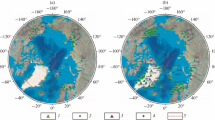Abstract
Major earthquakes in the world, especially the ones above magnitude 7.0 are affected by the positions of celestial objects. The node of the lunar orbit with the earth's orbit moves westwards on the ecliptic, with a period of 18.6 years. The precession of the lunar ascending node causes the inclinationbetween the moon's path and the celestial equator to change continuouslyfrom 18.28° to 28.58°. The seismic activities of the mainseismic belts in the world are affected by the period of 18.6 years and onlytheir active periods appear alternately, which shows that different locationsof the moon correspond to different seismic belts or regions on the earth.1425 of the 1861 earthquakes over magnitude 7.0 that happened inthe whole world from 1900 to 1996 occurred at or near the extreme valuepoints of the horizontal component of the tide generating forces, which are77% of the total and much larger than the natural probability, 50%. It isshown that the triggering effect of the celestial objects on an seismic activityis mainly from the horizontal component of the tide generating forces, notfrom the vertical one.
Similar content being viewed by others
References
Bendat, J. S. and Piersol, A. G.: 1971, Random Data: Analysis and Measurement Procedures, Wiley-Interscience.
Chen, L.: 1996, Cerebration of the scientific guide lines, methodology and difficulties in earthquake prediction, Journal of Seismological Research 15(2), 1–6, in Chinese.
Du, P. and Xu, D.: 1989, Astroseismologic Introduction, Seismological Press, pp. 100–240, in Chinese.
Du, P.: 1996, 18.6 years cycles of large intermediate and deep focus earthquakes in the world's major seismic regions, Acta Geophysics Sinica 39, 3, in Chinese.
Fang, J.: 1984, Solid Earth Tides, Scientific Press, pp. 156–437, in Chinese.
Guo, Z., Qin, B., and Guo, A.: 1996, Crust-Atmosphere Coupling and Natural Calamity Prediction, Seismological Press, pp. 116–210, in Chinese.
Han, Y., Li, Z., and Hu, H.: 1998, Interdisciplinary studies of astronomical factors and earthquakes in China, International Association of Geodesy Symposia, IAG Scientific Assembly, Rio de Janeiro, September 3-9, 1997, Vol. 119, 465–471, Springer Press.
Hu, H. and Li, X.: 1999, Analysis of astronomical characteristics of major earthquakes in China, Journal of Natural Disasters 8(1), 30–34, in Chinese.
Hu, H., Zhao, H., Li, X., and Wang, R.: 1994, Analysis of the astronomical characteristics of major earthquakes in China, Proceedings of International Workshop on Seismotectonics and Seismic Hazard in South East Asia, Hanoi, Vietnam, pp. 57–60.
Li, D.: 1994, Is the gravitational acceleration a constant? Earth and Geophysics, Seismological Press, pp. 78–96, in Chinese.
Luan, J.: 1988, Motion of Planets and Long Term Weather and Earthquake Forecast, Beijing Normal University Press, 248 pp., in Chinese.
Ma, Z.: 1982, 1966-1976 Chinese Nine Major Earthquake, Seismological Press, pp. 1–128, in Chinese.
McCarthy, D. D. (ed.): IERS standards (1989), IERS Technical Note 3, November 1989, Observatoire de Paris, pp. 1–76.
Melchior, P.: 1978, The Tides of the Planet Earth, Pergamon Press, pp. 168–247.
Niesmianovin, E. I.: 1984, The Possibility of Accurate Time Prediction for an Earthquake, The Deep Earth Crust Structure in Upper Mantle Boundary Layer, Science Press, Kiev, pp. 197–204, in Russian.
Ren, Z.: 1982, Analyses of relationship between Hebei major earthquakes and new Moon and full Moon, Chinese Science Bulletin 27, 10, in Chinese.
Sadeh, D. S. and Meidaw, M.: 1973, Search for sidereal periodicity in earthquake occurrences, J. Geophys. Res. 78, 7709–7716.
Shi, Z.: 1981, The Catalogue of the Global Earthquakes, Seismological press, in Chinese.
Yan, J., Shi, Z., Wang S., and Huan, W.: 1979, Regional Characteristics of Modern Tectonic Stress in China and the Neighboring Regions 1(1), 9–24, in Chinese.
Zi, X.: 1980, Influence of positional change of celestial objects to earthquake from Tanghai earthquake, Journal of Seismological Research in Chinese.
Zoback, M. L., Zoback, M. D., Aadms, J., Assumpcao, M., Bell, S., Bergman, E. A., Blumling, P., Brereton, N. R., Denham, D., Ding, J., Fuchs, K., Gay, N., Gregersen, S., Gupta, H. K., Gvishiani, A., Jacob, K., Klein, R., Knoll, P., Magee, M., Mercier, J. L., Muller, B. C., Paquin, C., Rajendran, K., Stephansson, O., Suarez, G., Suter, M., Udias, A., Xu, Z. H. and Zhizhin, M.: 1989, Global patterns of tectonic stress, Nature 341, 6240291–6240298.
Author information
Authors and Affiliations
Rights and permissions
About this article
Cite this article
Hui, H., Xiaoming, L. Research on Correlation of Positions of Celestial Objects with Earthquakes. Natural Hazards 23, 339–348 (2001). https://doi.org/10.1023/A:1011115708096
Issue Date:
DOI: https://doi.org/10.1023/A:1011115708096




